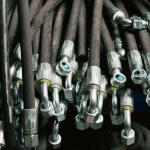Inspect, Repair, Replace: End-of-Year Checklist for Hydraulic Systems
As the year winds down, many manufacturers and industrial operators take the opportunity to perform critical equipment inspections before the new year begins. For systems that rely on hydraulic components, this end-of-year check isn’t just about routine upkeep, but about safeguarding productivity, preventing downtime, and extending the lifespan of your machinery.
Hydraulic systems power some of the most essential operations across construction, manufacturing, and logistics. Over time, even minor wear in a hydraulic valve, hydraulic pump, or hydraulic cylinder can lead to performance drops, inefficiencies, or costly failures.
Step 1: Inspect Your Hydraulic Valve
Your hydraulic valve is the control center of your system, regulating flow and directing pressure where it’s needed most. Start your inspection by checking for leaks around the valve body, loose fittings, or corrosion. Dirt and debris are common culprits of sluggish or inconsistent operation, so it’s important to clean and visually inspect each valve for contamination.
If you notice erratic motion or unexpected pressure changes, this may indicate internal leakage or a sticking valve spool. Addressing these issues early prevents cascading problems in other components like the hydraulic pump and hydraulic cylinder.
Step 2: Test and Tune the Hydraulic Pump
The hydraulic pump serves as the heart of your system, converting mechanical energy into hydraulic pressure. Before shutting down for the holidays, check the pump for noise, vibration, or pressure irregularities – all of which can signal early-stage wear.
Inspect seals and gaskets, monitor oil levels, and ensure your fluid is clean and free from discoloration or particles. A contaminated fluid supply can cause major damage to both the hydraulic pump and connected components downstream, like valves and cylinders.
Step 3: Evaluate Hydraulic Cylinders for Wear
The hydraulic cylinder is where your system’s power meets motion. Any signs of rod scoring, seal leaks, or pitting should be addressed immediately. A small amount of fluid leakage may seem minor, but over time, it can cause a serious drop in pressure and responsiveness.
Look for misalignment or side loading, which can wear out the rod and seals unevenly. Be sure to also check mounting hardware and pivot points for looseness or wear. When a hydraulic cylinder begins to lose efficiency, it often puts added strain on the hydraulic pump, creating a chain reaction of stress across the system.
Step 4: Document and Plan Ahead
Once inspections are complete, it’s time to determine whether components should be repaired or replaced. In some cases, resealing a hydraulic valve or rebuilding a hydraulic cylinder is enough to restore full performance. However, if your hydraulic pump shows signs of major internal wear or poor efficiency, a full replacement may be the most cost-effective solution long-term.
The end of the year is an ideal time to schedule replacements, especially before budget cycles reset or before your team returns to peak production.
Step 5: Document and Plan Ahead
Finally, don’t overlook documentation. Keep detailed records of what was inspected, repaired, or replaced, along with fluid changes and part numbers. This information becomes invaluable for planning preventative maintenance in the new year.
By establishing a proactive maintenance routine, you will reduce unplanned downtime, extend component lifespan, and maintain consistent system efficiency.
Partner with Experts You Can Trust: Air & Hydraulic Equipment
With decades of industry experience, Air & Hydraulic Equipment provides customized solutions for every stage of hydraulic system maintenance.
Contact us at Air & Hydraulic Equipment to schedule your year-end inspection.









